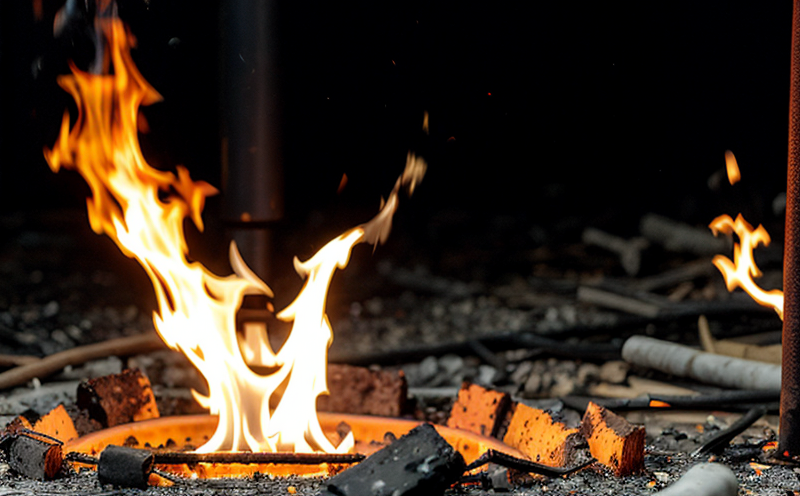ASTM F963 Surface Finish and Coating Flammability
The ASTM F963-17 standard provides essential guidelines for testing the flammability of toys to ensure they are safe for children. This test evaluates whether a toy's surface finish or coating may ignite under certain conditions, which is particularly critical in the toy manufacturing sector where materials and coatings can vary widely.
The ASTM F963-17 standard focuses on ensuring that toys meet stringent safety requirements before being marketed to the public. Flammability testing aims to protect children from potential hazards by identifying any surfaces or coatings that could ignite easily, which might pose a fire risk if exposed to heat sources such as matches or cigarettes.
Flammability tests are conducted using specific apparatus and procedures outlined in ASTM F963-17. The test involves applying a flame source to the toy's surface finish or coating and measuring various parameters that indicate whether the material ignites, burns away, or continues burning after removal of the flame. These measurements help determine if the toy passes or fails based on predefined acceptance criteria.
The testing apparatus used includes a standard flame source, such as a Bunsen burner, and a calorimeter to measure heat release rates. Specimens are typically cut from the toy's surface finish or coating material according to ASTM F963-17 specifications. The test results are reported based on time-to-flame-out, burn duration, and mass loss.
Understanding the implications of these tests is crucial for quality managers, compliance officers, R&D engineers, and procurement specialists involved in toy manufacturing. By ensuring that toys meet ASTM F963-17 requirements, manufacturers can avoid costly recalls, legal issues, and damage to brand reputation. Non-compliance with this standard could result in product bans or market withdrawals.
Flammability testing also plays a vital role in the development of new materials and coatings used in toys. By identifying potential flammable areas early on, R&D engineers can work towards safer alternatives that still meet aesthetic and functional requirements. This proactive approach ensures continuous improvement in toy safety standards.
In summary, ASTM F963-17 is an indispensable tool for the toy industry, providing a framework to assess the risk of fire associated with toys' surface finishes or coatings. By adhering to this standard, manufacturers can enhance product safety and trust among consumers.
Industry Applications
- Toys for Infants: Testing the flammability of materials used in toys intended for infants is critical due to their small size, which increases the risk of accidental ingestion or exposure.
- Soft Toys with Coatings: Soft toys often have intricate coatings applied to enhance durability and appearance. Ensuring these coatings do not pose a fire hazard is essential for consumer safety.
- Metallic Elements in Toys: Metallic elements like buttons, decorations, or components can be coated with various materials. Testing their flammability helps identify any potential risks associated with these surfaces.
- Plastic Parts of Toys: Plastic parts are commonly used in toys and may have surface finishes that require testing to ensure they do not ignite easily under normal conditions.
The ASTM F963-17 standard ensures that all materials and coatings used in toy production undergo rigorous flammability testing, thereby protecting children from potential fire hazards. This comprehensive approach covers a wide range of toy components, ensuring that each part meets the stringent requirements set forth by this internationally recognized standard.
Eurolab Advantages
Eurolab offers unparalleled expertise in ASTM F963-17 compliance testing for surface finishes and coatings used in toys. Our state-of-the-art facilities are equipped with advanced apparatus to perform the required tests accurately and consistently.
- Accreditation: Eurolab is ISO/IEC 17025 accredited, ensuring that our testing processes meet international standards for competence and accuracy.
- Experience: Our team of experienced engineers and scientists has extensive knowledge in toy safety regulations across various countries, including the United States, Europe, and Asia.
- Technology: We use cutting-edge equipment to conduct flammability tests according to ASTM F963-17 specifications, guaranteeing reliable results.
- Support: Eurolab provides comprehensive support throughout the testing process, from specimen preparation to final report generation. Our team offers insights and recommendations based on test outcomes to help you improve product safety.
Eurolab's commitment to excellence in toy safety testing ensures that your products meet all necessary standards, enhancing consumer confidence and protecting your brand reputation.
Quality and Reliability Assurance
- Consistent Results: Our ISO/IEC 17025 accreditation guarantees that every test conducted at Eurolab adheres to international standards, ensuring consistent and reliable results.
- Expertise: Our team of qualified professionals brings extensive experience in toy safety regulations from around the world. This expertise allows us to provide accurate interpretations of ASTM F963-17 requirements.
- Precision Instruments: Eurolab utilizes precise instruments and advanced technology to conduct flammability tests, ensuring accurate measurement of key parameters like time-to-flame-out and burn duration.
- Comprehensive Reporting: After completing ASTM F963-17 testing, we provide detailed reports that include all relevant data, analysis, and recommendations. These reports are essential for maintaining compliance with international toy safety standards.
Eurolab's focus on quality and reliability ensures that your products not only meet but exceed the stringent requirements set by ASTM F963-17. By choosing Eurolab for your ASTM F963-17 testing needs, you can rest assured knowing that your toys are safe and reliable.





